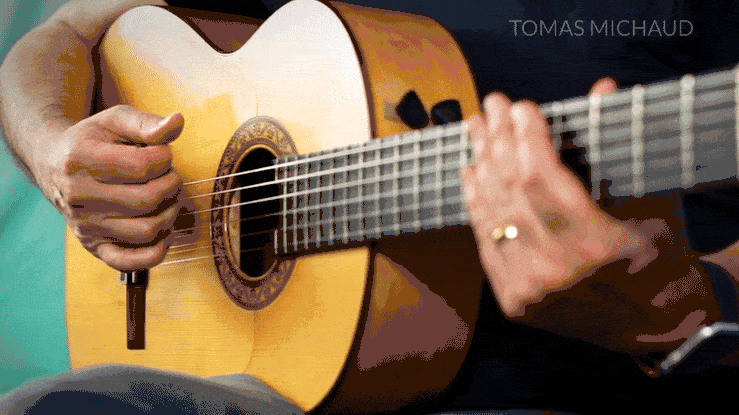Having a solid assortment of strumming patterns under your guitar playing belt is one of the best ways you can prepare yourself to learn to play the guitar.
This is especially true for the more common strumming patterns such as the Muted Strum!
Having a muted strum as well as other strum techniques mastered, will help you to gain a greater sense of rhythm in your chord progressions. It can also be used for single note melodies or bass lines.
How To Play The Muted Strum

The foundation of this muted strum is using your right hand to mute (or muffle) the strings when you strum.
There are two different types of mutes on a guitar. One with your right hand and one with your left hand.
The right hand mute can make the strings stop entirely (like we'll do here), and it can also let them ring in a muffled way.
That's called a palm mute and that's a whole different lesson.
The left hand mute happens when you release your fingers from fretting the notes.
This works particularly well with barre chords because you're touching every string. But you can use it on open chords as well.
But today we're talking about the right hand mute. You can think of the action as a mix between a strum and a chop.
I'm going to assume that you've watched the video to get a sense of how it sounds. It's very percussive and you can really create a lot of groove with it.
The Basic Technique
Start by muting your strings with your left hand. This is just to clean things up while you're working on your right hand technique.
With the strings muted, slap or chop your strings close to the bridge with your right hand. Somewhere between the end of your palm and side of your hand should be hitting the strings.
Then with your right hand still on the strings, strum.
The strum should be completely muted. In two different motions, you'll chop then strum.
Try this a few times to get the hang of it. This will eventually be one smooth motion, but it's important to deconstruct what the muted strum actually is.
Adding An 'Up' Strum

Here's where you'll make the two steps, chop and strum, into a single motion. You'll also add an up strum as well.
Before we get to the up strum, try the chop and strum in the single motion. Sound good? Good! Don't worry if it's not perfect.
Now form a G chord. With your right hand do the muted strum (one action) and then play the G chord with an up strum.
Try that a few times. The muted strum shouldn't have any notes ringing.
Try adjusting where you're chopping and strumming with your right hand if you need to.
The chop-strum-chop-strum pattern can be a song in itself, but we're going to add some more dynamics to this.
Check out 7:33 in the video to hear the full pattern.
Another Way To Practice The Muted Strum
If you found this technique a little tricky, then here's another approach you can take.
Some people find it helpful to practice muting single strings first. You have less strings to worry about and you can focus just on your right hand.
This is actually the palm mute technique I mentioned earlier. While it's different, the overall concept is the same.
Instead of chopping, just place your right hand on the strings. Now play a note, like the 3rd fret on the 6th string.
With the string muted, pick the note. It should ring out just slightly, while still being muffled. Move your hand back and forth from the bridge to find that perfect spot.
This is a good way to practice small movements. Small movements help you to play faster and cleaner, so learning to make them now will set you up for success later on.
If you enjoyed this lesson, then you'll like my Real Guitar Success program. We take this same deconstruction approach to a lot of techniques. And remember, learning to play guitar takes time and practice. So have fun with this!
